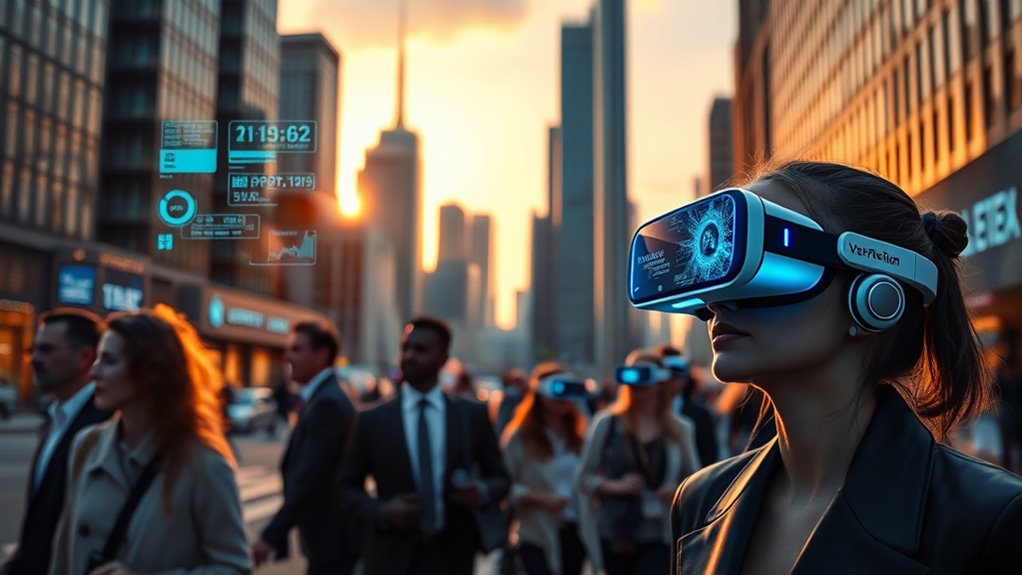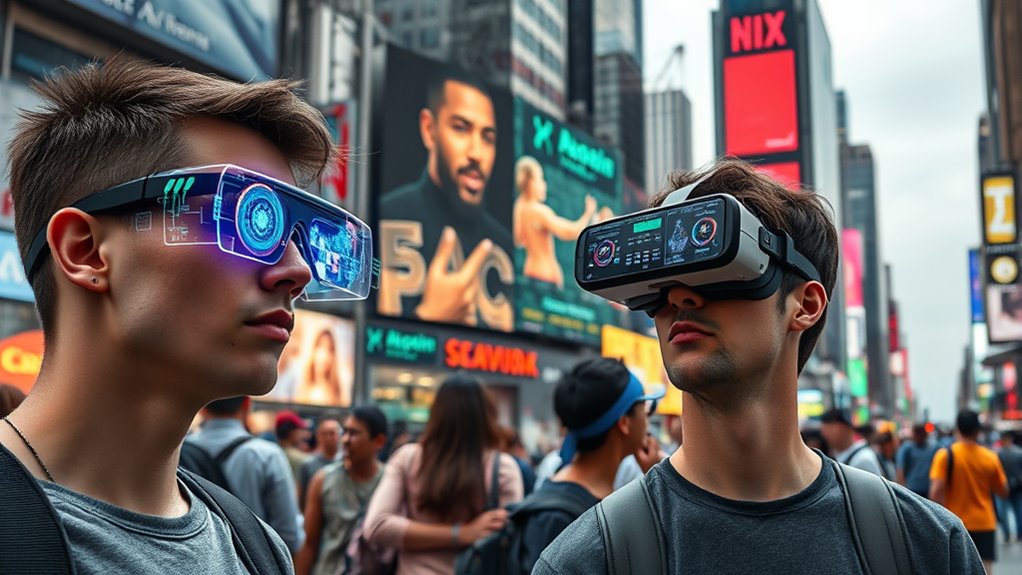By 2025, AR and VR will markedly change how you work, learn, and socialize, but the hype often overshadows the reality. Expect more immersive digital environments for meetings and social gatherings, though devices may still be bulky and limited by technology. Privacy concerns will grow as personal data collection increases, and some experiences might not match expectations. If you keep exploring, you’ll discover how these innovations truly shape everyday life and where their limits lie.
Key Takeaways
- By 2025, AR and VR will significantly transform daily life, work, and social interactions through immersive digital environments.
- Privacy and data security concerns will intensify due to extensive personal data collection in virtual platforms.
- Hardware limitations, such as bulkiness and limited battery life, may still hinder seamless adoption and realistic experiences.
- Virtual interactions will become more natural with advanced avatars, but some experiences may still fall short of expectations.
- Widespread adoption will be gradual, with ongoing innovations needed to bridge the gap between hype and practical reality.

By 2025, augmented and virtual reality will have transformed how you work, learn, and socialize. You’ll find yourself immersed in digital environments that feel almost real, whether you’re attending a virtual meeting, exploring a new city, or collaborating on a project. But as exciting as these advancements sound, you’ll also face some hurdles. Privacy concerns will be front and center, with many questioning how your personal data is collected, stored, and used within these immersive platforms. Companies will gather vast amounts of information about your behaviors, preferences, and even emotional responses, raising fears about surveillance and data security. You’ll need to stay vigilant about what you share and how your information is protected, especially as these technologies become more integrated into daily life.
Alongside privacy issues, technological limitations will temper the hype. Despite rapid progress, AR and VR devices in 2025 won’t be perfect. Headsets might still be bulky, uncomfortable, or limited in battery life, making prolonged use challenging. Visual fidelity, while impressive, may not fully match real-world clarity, especially in complex or detailed environments. Latency—delays between your movements and what you see—could still occasionally disrupt the sense of immersion, pulling you out of the experience. Additionally, some virtual environments might lack the realism needed for certain professional or educational applications, slowing their widespread adoption. You might find that some experiences still feel like prototypes rather than fully polished products, which can affect your perception of their reliability and usefulness.
Despite these shortcomings, the potential of AR and VR in 2025 is undeniable. As hardware improves and software becomes more sophisticated, you’ll probably notice more seamless integration into your routines. Virtual meetings could feel more natural, with avatars that accurately reflect facial expressions and gestures, reducing misunderstandings. Learning experiences could become more interactive and engaging, with virtual labs or historical reconstructions that bring subjects to life. Socially, these environments might offer new ways to connect, especially for those separated by distance or physical limitations. Still, the reality of technological limitations means you’ll need to be patient and discerning. Not every promised feature will be immediately available, and some experiences may not meet your expectations until further innovations emerge.
Frequently Asked Questions
What ARe the Main Barriers Preventing Widespread AR and VR Adoption by 2025?
You’ll find that hardware limitations and content scarcity are the main barriers to widespread AR and VR adoption by 2025. Because devices remain expensive and bulky, they’re less accessible for everyday use. Plus, the limited quality and variety of available content make it hard for you to stay engaged or see practical value. Overcoming these issues requires better hardware and a richer library of immersive experiences, which still need development.
How Will AR and VR Impact Privacy and Data Security Concerns?
You’ll face increased privacy and data security concerns with AR and VR, especially around data encryption and user consent. As these technologies collect detailed personal data, it’s essential that you understand how your information is protected. Companies must implement strong data encryption to prevent breaches and guarantee you give informed consent for data collection. Staying vigilant and demanding transparency helps protect your privacy as AR and VR become more integrated into daily life.
Will AR and VR Technology Become Affordable for Everyday Consumers?
Yes, AR and VR will become more affordable for everyday consumers. Thanks to ongoing cost reduction and hardware innovation, devices will get cheaper and more accessible. As manufacturers improve manufacturing processes and introduce budget-friendly options, you’ll find that immersive experiences are within reach. Expect lighter, more comfortable gear with better battery life, making AR and VR practical for daily use without breaking the bank.
How Will AR and VR Influence Social Interactions and Relationships?
Imagine slipping on a headset and suddenly sharing a laugh with a loved one across the globe, feeling virtual intimacy as if they’re right beside you. AR and VR will deepen social connectivity, making interactions more immersive and meaningful. You’ll forge stronger bonds, even from afar, transforming how you connect, communicate, and build relationships. These technologies will bridge distances, making social interactions richer, more personal, and vividly real.
What Ethical Considerations ARise With Advanced AR and VR Applications?
You need to consider ethical issues like digital consent and data ownership with advanced AR and VR apps. Make sure you’re aware of how your data is collected, stored, and shared, and always give informed consent before engaging. Developers should prioritize transparency and user control, ensuring you maintain privacy and autonomy. By addressing these concerns, you help create a responsible environment for immersive experiences that respect your rights.
Conclusion
By 2025, augmented and virtual reality will weave seamlessly into your daily life, transforming how you work, play, and connect. Imagine slipping on a headset and stepping into a vibrant, immersive world where digital and physical blend effortlessly. While the hype promises a future of boundless possibilities, you’ll find that reality grounds these innovations—shaping a landscape both exciting and familiar. Together, you’ll navigate this evolving frontier, where technology paints new horizons just beyond the horizon.










